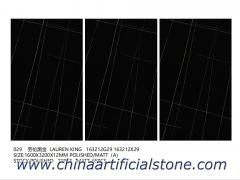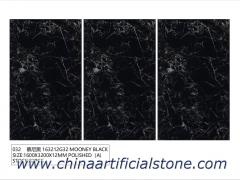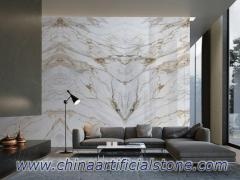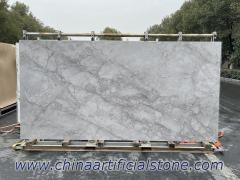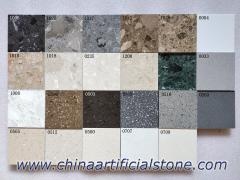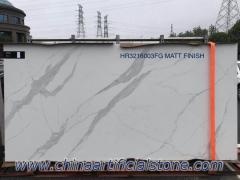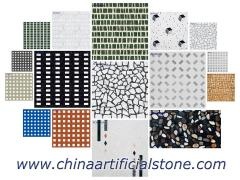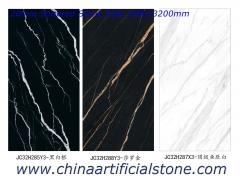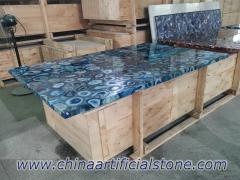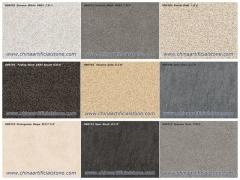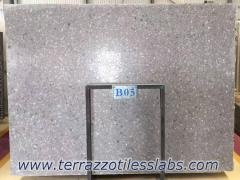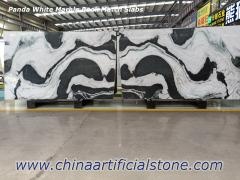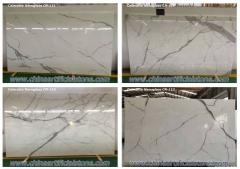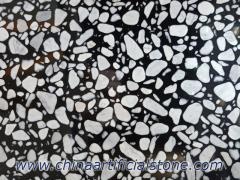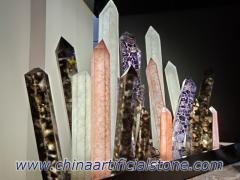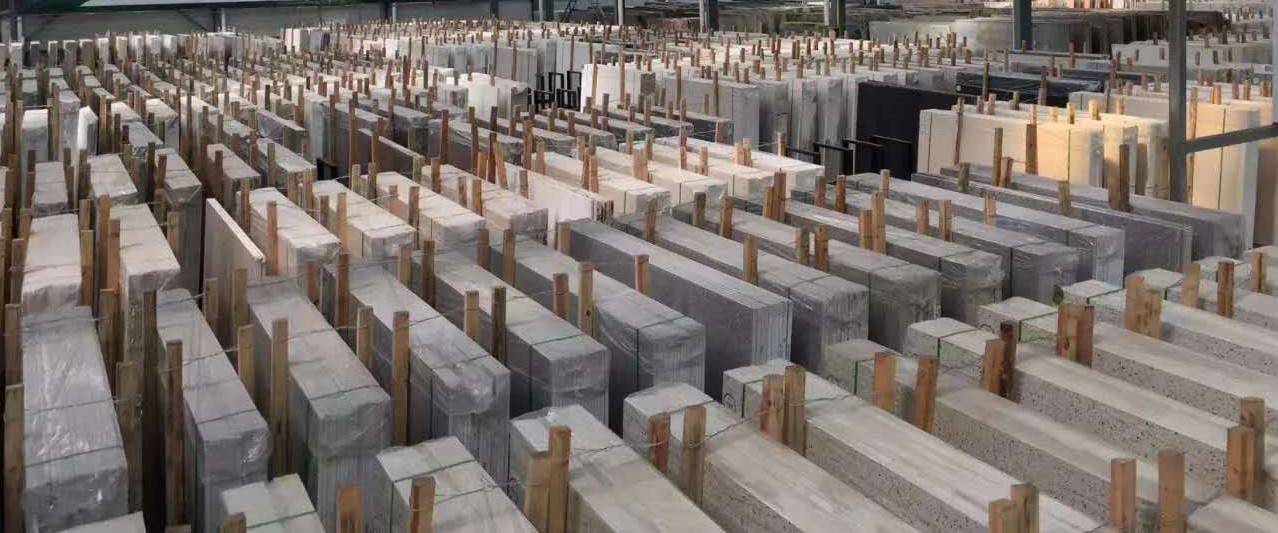
Many customers will have some questions: What is the difference between cement-based terrazzo and epoxy terrazzo? Is cement-based terrazzo or epoxy terrazzo better? Which one is more suitable for our design?
Let's answer them one by one below.1. What are epoxy terrazzo and cement-based terrazzo?
The concept of epoxy terrazzo and cement-based terrazzo
The earliest concept of terrazzo is water terrazzo, which is also a kind of cement-based terrazzo. It has a history of more than 100 years. Later, with the development of cement-based materials and epoxy materials, especially the breakthroughs in materials and processes in recent years, cement-based terrazzo and epoxy terrazzo materials classified by material properties were introduced.
The new concept of terrazzo is made by mixing gravel, glass, quartz and other aggregates with different materials (cement-based or epoxy) binders to make concrete products, and then surface grinding treatment by professional machinery and professionals. Sealed, solidified, polished and finished products.
Here comes the point:
Cement-based terrazzo: The terrazzo made of cement, glass or other cement-based binders is called cement-based terrazzo (such as cement-based terrazzo, glass-based terrazzo, etc.).
Epoxy terrazzo: The terrazzo made with epoxy, polyurethane or acrylic adhesives is called epoxy terrazzo (such as epoxy terrazzo, polyurethane terrazzo, acrylic terrazzo, etc.).
We now only compare the latest and most popular epoxy terrazzo and cement-based terrazzo (new cement-based self-leveling terrazzo). Other terrazzo can be used as a supplement to these two types of terrazzo, especially functionalized special terrazzo.
Both epoxy terrazzo and cement-based terrazzo have the following characteristics:
The whole is seamless, easy to clean, non-toxic and environmentally friendly, wear-resistant, impact-resistant, water-resistant, and durable. Moreover, because of its mosaic pattern, the color can be spliced arbitrarily, the artistic appreciation and practicality of terrazzo have been perfectly combined. The patterns can be combined at will, the colors are colorful, the surface is smooth and delicate, highlighting the dignity and dignity, has become a designer and owner The first commercial floor material, especially suitable for the ground decoration of large shopping malls, mid-to-high-end commercial buildings, luxury clubs, exhibition halls, hotels, residences and villas.
1. Construction technology
It is recommended that whether it is epoxy terrazzo or cement-based terrazzo, a leveling layer is required to prevent the risk of terrazzo cracking due to cracking of the base layer.
Epoxy terrazzo construction process:
Grassroots treatment: sanding, repairing the grassroots, cleaning and drying;
Primer: Epoxy primer roller brush once
Surface coating: mix the epoxy terrazzo base material with colored stones, glass and other aggregates, pave and screed; after curing, use a special machine to polish and polish several times;
Floor thickness: 6~10mm
Cement-based terrazzo construction process:
Grassroots treatment: wash planing or shot blasting the grassroots, clean and dry;
Primer: Apply the interface treatment agent twice
Surface coating: Special cement-based self-leveling materials are mixed with colored stones, glass, etc. to pave, scrape, and deflate; after curing, use special machinery to smooth and polish several times;
Floor thickness: 10-15mm
2. Difficulty of construction
Epoxy terrazzo floor: more complicated
Cement-based terrazzo floor: a little simpler than epoxy terrazzo
3. Make pattern attributes
Epoxy terrazzo floor: slightly stronger
Cement-based terrazzo floor: slightly worse
4. Color decoration
Epoxy terrazzo floor: The color is brighter, but there will be a slight yellowing over time, which affects the aesthetics, especially in light and non-light areas, there will be more obvious color differences after a long time.
Cement-based terrazzo floor: Will not turn yellow, and the color will not change after decades.
5. Scratch resistance
Epoxy terrazzo floor: poor
Cement-based terrazzo floor: very good
6. Mohs hardness
Epoxy terrazzo floor: 5-6
Cement-based terrazzo floor: 7+
7. Price comparison
Epoxy terrazzo floor: relatively expensive
Cement-based terrazzo floor: moderate
8. Gloss
Epoxy terrazzo floor: 80+
Cement-based terrazzo floor: 80+
9. Clarity
Epoxy terrazzo floor: about 95
Cement-based terrazzo floor: around 95
10. Construction period
Epoxy terrazzo floor: long
Cement-based terrazzo floor: short
11. Fire and flame retardancy
Epoxy terrazzo floor: the fire rating can only reach B level
Cement-based terrazzo floor: the fire rating can reach A1
12. Environmental performance
Epoxy terrazzo floor: a small amount of VOC is released, which is a material controlled by the state
Cement-based terrazzo floor: zero VOC, low-carbon, environmentally friendly and energy-saving material
13. Construction safety
Epoxy terrazzo floor: unsafe, easy to catch fire
Cement-based terrazzo floor: It is safe to cure the product with water.
14. Service life
Epoxy terrazzo floor: generally 15-20 years
Cement-based terrazzo floor: the same life span as the base
15. Future development trend
For the future development trend, my opinion:
Epoxy terrazzo floor: Improve scratch resistance by improving the toughness of epoxy-based materials. It can also use polyurethane and acrylic materials as terrazzo to achieve some performance requirements that epoxy terrazzo cannot meet (such as acid resistance, alkali resistance, Chemical resistance, etc.). At the same time, a solvent-free epoxy terrazzo system can be developed to reduce VOC content and truly environmentally friendly products.
Cement-based terrazzo floor: Due to the complexity of cement-based materials, the control of material quality is the key to the quality of the final product. Due to the popularity of nanomaterials, cement-based terrazzo materials have greater development potential.
16. Problems to be solved
Whether it is epoxy terrazzo or cement-based terrazzo, it has been gradually recognized by customers because of its irreplaceable characteristics. However, because there is no national standard at this stage, the product performance is very different, which limits the popularization of products. It is recommended to establish corresponding standards as soon as possible To standardize products to prevent fake and inferior products from damaging the reputation of products and affecting the long-term development of products.









